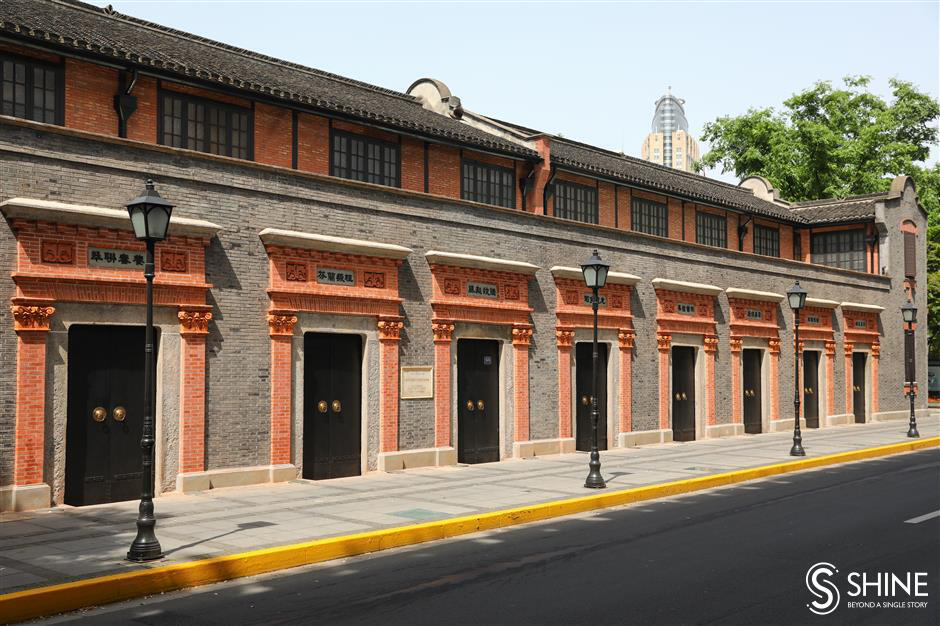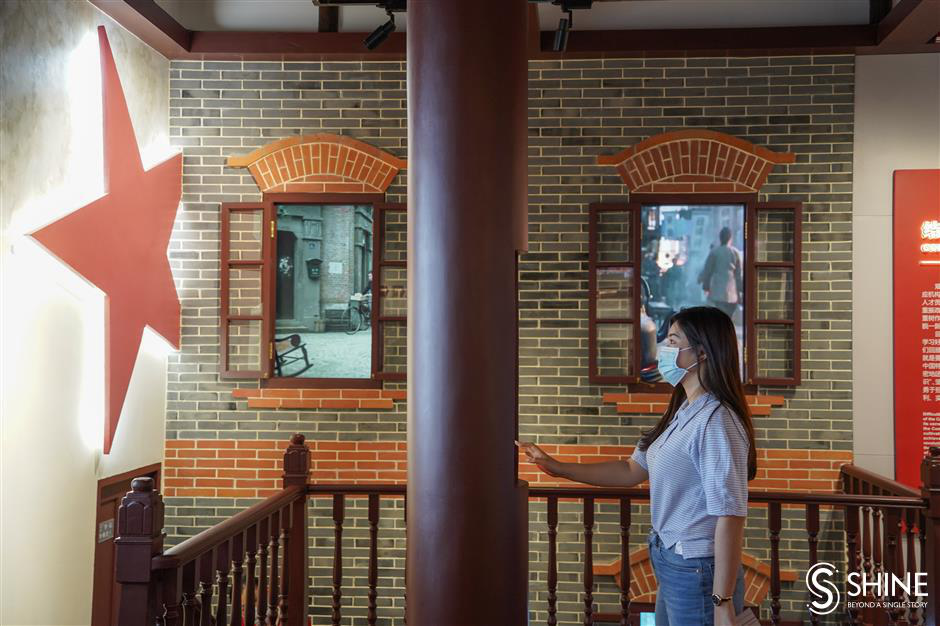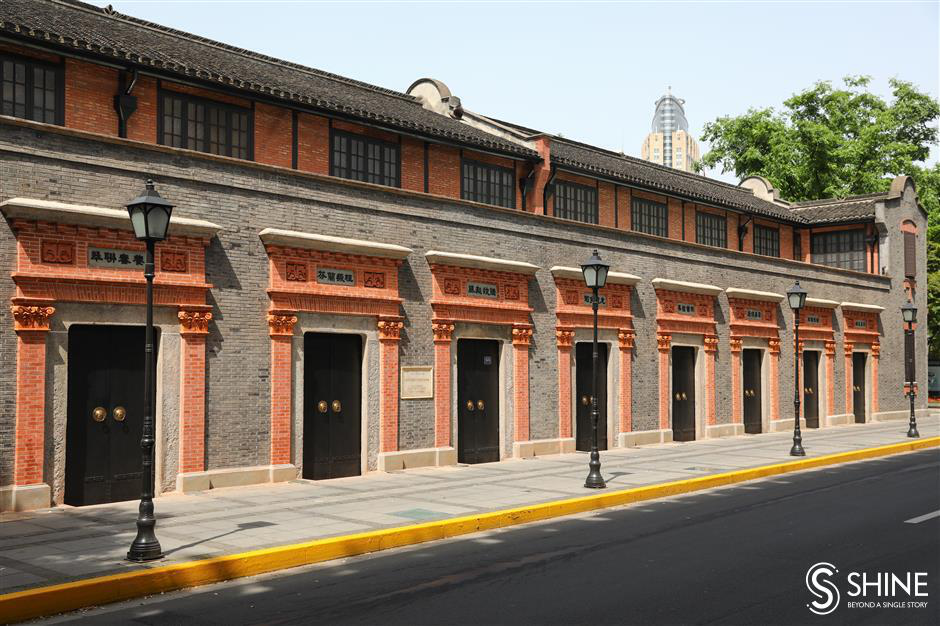
The Memorial Hall of the Second National Congress of the Communist Party of China reopens after a 169-day renovation.
A newly restored "red" site has truly become a "memorial built in the shell of shikumen (stone-gate)."
After a 169-day renovation, the site of the Second National Congress of the Communist Party of China was reopened to the public on May 4.
It has been restored to the way it looked when it was completed in 1915 as part of the former Fudeli shikumen neighborhood, especially its façade facing Yan'an Road M. – featuring eight doorways, 16 brick columns and lintels.
The site brings people back to a century ago when early CPC members sheltered in cramped shikumen to carry out revolutionary work.
Initially, it was home to a major cofounder of the CPC Li Da, who moved into building No. 625 with his wife Wang Huiwu in April of 1921 shortly after they were married. Another founding CPC member Chen Duxiu often came to read documents.
Comprised of rows of similar-looking shikumen buildings, Fudeli was a wealthy neighborhood where the former International Settlement and French Concession met. It became one of the few remaining clandestine sites that survived police raids and shielded secret meetings.
Under Li's proposal, 12 CPC delegates gathered in secret at his house on July 16, 1922, to attend the second national congress.
Over eight days, Wang kept watch for them. She took her newborn daughter for a walk around the grounds every day. The delegates drafted the first CPC Constitution, consisting of six chapters and 29 terms.
Over the past 20 years, the site has been renovated and expanded several times. The latest renovation began last November.
"In previous renovations, workers just coated cement on original clay bricks. It's like daubing paint on human faces. It's stuffy," said Wu Gongbao, a veteran renovator of old buildings. "So in the first phase of the latest renovation, we washed away layers of 'makeup' from the façade. Then, we used natural limestone and incorporated traditional methods used by workers about a century ago to repair it."
The exhibition has also been upgraded to emphasize that the site was a memorial built in shikumen style.
Photos of the delegates are displayed in a glass wall, through which visitors have a view of a typical shikumen neighborhood lane on the other side.
The conference room was recreated based on Wang's memory – simply with a table and some chairs.
A depiction of the meetings can be seen in artist Yu Xiaofu's oil painting.
For the first time, visitors can also take in a 360-degree view of the early People's Publishing House on a digital screen. In September of 1921, Li established the People's Publishing House here, which is still one of the most reputable publishers in China.
It started as a one-man workshop, with Li serving as editor, proofreader and publisher. To prevent the publication from being discovered by the ruling Kuomintang government, Li printed a fake address and disguised CPC propaganda leaflets as New Year's cards.
Address: 30, Lane 7, Laochengdu Rd N.
Opening hours: 9am-4:30pm, Tuesdays-Sundays
Tel: 6359-0984

The Memorial of the Central Military Commission of the Communist Party of China
A tale of betrayal and murder
A new memorial honoring martyrs and the armed struggle against reactionaries in the early days of the Communist Party of China opened on May 10.
The Memorial of the Central Military Commission of the Communist Party of China comprises a row of four century-old shikumen houses from the former Jingyuanli neighborhood. Building 1015 was the site of real-life cloak-and-dagger story.
Bai Xin, a secretary at the commission, and his wife lived there in 1928. Early CPC leaders such as Zhou Enlai, Peng Pai and Yang Yin came in disguise as the couple's mahjong pals to shield secret meetings.
However, Bai bore a grudge against Peng for having killed a deserter who was Bai's relative, so he betrayed Peng and tipped off the Kuomintang government about a secret meeting on August 24, 1929.
Zhou should have been there but did not make it, because he had to deal with more important matters.
While the meeting was in progress, armed Kuomintang police and soldiers broke into the house and arrested Peng, Yang, Yan Changyi, Xing Shizhen and Zhang Jichun. Zhou organized a rescue operation but it failed. Six days later, all but Zhang were killed at Longhua prison.
The scene at Building 12 has been reenacted and Bai's bedroom restored. Exhibits about the four martyrs are on display in the exhibition hall next door, such as letters written to the CPC and their families.
Texts, photos, audio recordings and videos are displayed in the 192-square-meter exhibition hall, chronicling the commission's establishment and the CPC's military strategy during wartime. Of the exhibits, nearly half are copies of cultural relics.
The Central Military Commission was established Shanghai in October of 1925. In January 1933, it moved its office to the revolutionary base in Jiangxi Province.
Address: 12, Lane 613, Xinzha Rd
Opening hours: 9am-4:30pm, Tuesdays-Sundays
Tel: 3178-3930




 A single purchase
A single purchase









